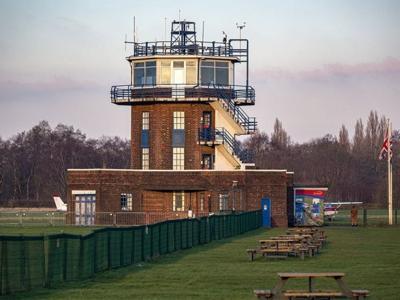Fri, Jul 21, 2023
ADS-B Position Data System Approved by U.K. CAA
The U.K. Civil Aviation Authority (CAA) has formally approved Manchester Barton Aerodrome’s (EGCB) ADS-B Flight Information Display (FID) utilizing the uAvionix pingStation to receive ADS-B position data from aircraft on the ground and flying in the vicinity of the airfield. The low-cost safety system provides real-time position data to air traffic staff operating in the tower and is the first ever FID approved for use in the UK under the CAA’s new FID regulations.

The concept of a Flight Information Display is a recognition that the use of ADS-B OUT-equipped aircraft enables low-cost airspace and aerodrome/airport situational awareness at a cost and scale not previously imagined. Prior to the advent and widespread adoption of ADS-B, multi-million-dollar radar solutions were required to provide surveillance capabilities. These technologies were cost-prohibitive, leaving most aerodromes/airports without any technological surveillance capability at all, instead relying on the line-of-sight visual capabilities of controllers in combination with radio communications. Since ADS-B OUT equipment relies on readily available certified or qualified equipment broadcasting the aircraft’s position from an approved high-integrity position source, the ground-based surveillance and display capability needed to provide situational awareness can be produced at a fraction of the cost of the legacy radar solutions.
Barton’s FID uses a uAvionix pingStation to receive ADS-B position data that is passed to the local FID computer, which displays the traffic situation to the Flight Information Service Officer (FISO) in the tower. For many years, general aviation pilots have had access to technology, such as the uAvionix SkyEcho2, enabling them to receive and display the position of other ADS-B conspicuous aircraft flying nearby to help avoid collisions. The CAA approved FID now provides an equivalent low-cost capability for FISOs and Air Traffic Control Officers (ATCOs) in the airfield tower.

The new CAA FID regulations were developed following extensive UK trials that gathered data to validate the safety case for allowing non-radar rated FISOs and ATCOs to use ADS-B information for the reporting of traffic information to pilots. “The culmination of the trials, the announcement of the new regulations, and the Barton Aerodrome approval represent a significant enhancement to flight safety by bringing a low-cost surveillance solution to general aviation airfields using off the shelf hardware and applications that can be easily implemented,” noted Steve Hutt, CEO of Custom Chess Company, who guided the effort at Barton Aerodrome and oversaw the creation of FID templated documentation as a shared resource for all UK airfields.
More News
Also: Netherlands Donates 18 F16s, 2 737s Collide On Ramp, E-7 Wedgetail Cut, AgEagle's 100th In S Korea The Pilot and Aircraft Privacy Act was introduced in the House by Represent>[...]
Pilot Also Reported That Due To A Fuel Leak, The Auxiliary Fuel Tanks Were Not Used On June 4, 2025, at 13:41 eastern daylight time, a Piper PA-23, N2109P, was substantially damage>[...]
Have A Story That NEEDS To Be Featured On Aero-News? Here’s How To Submit A Story To Our Team Some of the greatest new stories ANN has ever covered have been submitted by our>[...]
From 2023 (YouTube Edition): Reflections on War’s Collective Lessons and Cyclical Nature The exigencies of war ought be colorblind. Inane social-constructs the likes of racis>[...]
What Goes Around, May Yet Come Back Around, Klyde FMI: www.klydemorris.com>[...]
 Airborne 06.30.25: US v ADS-B Misuse, Natl STOL Fire, Volocopter Resumes
Airborne 06.30.25: US v ADS-B Misuse, Natl STOL Fire, Volocopter Resumes NTSB Prelim: Piper PA-23
NTSB Prelim: Piper PA-23 ANN FAQ: Submit a News Story!
ANN FAQ: Submit a News Story! Classic Aero-TV: One Mans Vietnam
Classic Aero-TV: One Mans Vietnam Klyde Morris (06.30.25)
Klyde Morris (06.30.25)




